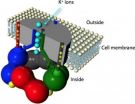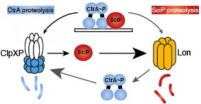BUSM study reveals potential target to better treat, cure anxiety disorders
2013-03-06
(Press-News.org) (Boston) – Researchers at Boston University School of Medicine (BUSM) have, for the first time, identified a specific group of cells in the brainstem whose activation during rapid eye movement (REM) sleep is critical for the regulation of emotional memory processing. The findings, published in the Journal of Neuroscience, could help lead to the development of effective behavioral and pharmacological therapies to treat anxiety disorders, such as post-traumatic stress disorder, phobias and panic attacks.
There are two main stages of sleep – REM and non-REM – and both are necessary to maintain health and to regulate multiple memory systems, including emotional memory. During non-REM sleep, the body repairs tissue, regenerates cells and improves the function of the body's immune system. During REM sleep, the brain becomes more active and the muscles of the body become paralyzed. Additionally, dreaming generally occurs during REM sleep, as well as physiological events including saccadic eye movements and rapid fluctuations of respiration, heart rate and body temperature. One particular physiological event, which is a hallmark sign of REM sleep, is the appearance of phasic pontine waves (P-waves). The P-wave is a unique brain wave generated by the activation of a group of glutamatergic cells in a specific region within the brainstem called the pons.
Memories of fearful experiences can lead to enduring alterations in emotion and behavior and sleep plays a natural emotional regulatory role after stressful and traumatic events. Persistence of sleep disturbances, particularly of REM sleep, is predictive of developing symptoms of anxiety disorders. A core symptom of these disorders frequently reported by patients is the persistence of fear-provoking memories that they are unable to extinguish. Presently, exposure therapy, which involves controlled re-exposure to the original fearful experience, is considered one of the most effective evidence-based treatments for anxiety disorders. Exposure therapy produces a new memory, called an extinction memory, to coexist and compete with the fearful memory when the fearful cue/context is re-encountered.
The strength of the extinction memory determines the efficacy of exposure therapy. A demonstrated prerequisite for the successful development of an extinction memory is adequate sleep, particularly REM sleep, after exposure therapy. However, adequate or increased sleep alone does not universally guarantee its therapeutic efficacy.
"Given the inconsistency and unpredictability of exposure therapy, we are working to identify which process(es) during REM sleep dictate the success or failure of exposure therapy," said Subimal Datta, PhD, director and principle investigator at the Laboratory of Sleep and Cognitive Neuroscience at BUSM who served as the study's lead author.
The researchers used contextual fear extinction training, which works to turn off the conditioned fear, to study which brain mechanisms play a role in the success of exposure therapy. The study results showed that fear extinction training increased REM sleep. Surprisingly, however, only 57 percent of subjects retained fear extinction memory, meaning that they did not experience the fear, after 24 hours. There was a tremendous increase of phasic P-wave activity among those subjects. In 43 percent of subjects, however, the wave activity was absent and they failed to retain fear extinction memory, meaning that they re-experienced fear.
"The study results provide direct evidence that the activation of phasic P-wave activity within the brainstem, in conjunction with exposure therapy, is critical for the development of long-term retention of fear extinction memory," said Datta, who also is a professor of psychiatry and neurology at BUSM. In addition, the study indicates the important role that the brainstem plays in regulating emotional memory.
Future research will explore how to activate this mechanism in order to help facilitate the development of new potential pharmacological treatments that will complement exposure therapy to better treat anxiety and other psychological disorders.
According to the National Institute of Mental Health, anxiety disorders affect approximately 40 million American adults each year. While anxiety can sometimes be a normal and beneficial reaction to stress, some people experience excessive anxiety that they are unable to control, which can negatively impact their day to day life.
###
Research included in this study was supported in part by the National Institutes of Health's National Institute of Mental Health under grant award number MH 59839 (PI: Datta) and the National Institute of Neurological Disorders and Stroke under grant award number NS 34004 (PI: Datta).
END
ELSE PRESS RELEASES FROM THIS DATE:
2013-03-06
Ann Arbor, Mich. — Each year, more than 130,000 children younger than 13 are treated in U.S. emergency departments after motor-vehicle crash-related injuries.
Each of these visits offer a chance to pass along tips for proper use of child passenger restraints, but a new study from the University of Michigan indicates emergency departments may not be taking advantage of those opportunities.
In the study published today in Pediatric Emergency Care, more than one-third of ER physicians say they are uncertain whether their departments provide information about child passenger ...
2013-03-06
WASHINGTON, D.C. — Women's issues play a major role in the health of the nation and should be a key consideration for policymakers as they design and set up the new insurance exchanges, according to a report co-authored by policy experts at the George Washington University School of Public Health and Health Services (SPHHS). The report offers a checklist for the state-based health insurance exchanges, one that will help ensure that women, children and family members can get the services they need to prevent costly and debilitating medical problems.
"Women often use a ...
2013-03-06
PHILADELPHIA - Omega-3 fatty acids found in oily fish may have diverse health-promoting effects, potentially protecting the immune, nervous, and cardiovascular systems.
But how the health effects of one such fatty acid -- docosahexaenoic acid (DHA) -- works remains unclear, in part because its molecular signaling pathways are only now being understood.
Toshinori Hoshi, PhD, professor of Physiology, at the Perelman School of Medicine, University of Pennsylvania, and colleagues showed, in two papers out this week in the Proceedings of the National Academy of Sciences, ...
2013-03-06
BETHESDA, MD – March 5, 2013 -- A team of European scientists from the University Medical Center Hamburg-Eppendorf (UKE) and the Cologne Excellence Cluster on Cellular Stress Responses in Aging-Associated Diseases (CECAD) at the University of Cologne in Germany has taken an important step closer to understanding the root cause of age-related dementia. In research involving both worms and mice, they have found that age-related dementia is likely the result of a declining ability of neurons to dispose of unwanted aggregated proteins. As protein disposal becomes significantly ...
2013-03-06
In Africa and Thailand, communities that worked together on HIV-prevention efforts saw not only a rise in HIV screening but a drop in new infections, according to a new study presented this week at the Conference on Retroviruses and Opportunistic Infections in Atlanta.
The U.S. National Institute of Mental Health's Project Accept — a trial conducted by the HIV Prevention Trials Network to test a combination of social, behavioral and structural HIV-prevention interventions — demonstrated that a series of community efforts was able to boost the number of people tested ...
2013-03-06
Chevy Chase, MD—In a Position Statement unveiled today, The Endocrine Society advocates that all methods for measuring estrogens, which play a crucial role in human biology, be made traceable to a common standard.
In addition to the well-known role of estrogens in sexual development, these hormones, particularly estradiol, have a significant impact on the health of the skin, blood vessels, bones, muscle, kidney, liver, digestive system, brain, lung and pancreas. Studies have linked changes in estradiol levels to coronary artery disease, stroke and breast cancer.
"Estradiol ...
2013-03-06
AMHERST, Mass. – Biochemists at the University of Massachusetts Amherst including assistant professor Peter Chien recently gained new insight into how protein synthesis and degradation help to regulate the delicate ballet of cell division. In particular, they reveal how two proteins shelter each other in "mutually assured cleanup" to insure that division goes smoothly and safely.
Cells must routinely dispose of leftover proteins with the aid of proteases that cut up and recycle used proteins. The problem for biochemists is that the same protein molecule can be toxic garbage ...
2013-03-06
A new report published today concludes that nearly half of Africa's wild lion populations may decline to near extinction over the next 20-40 years without urgent conservation measures. The plight of many lion populations is so bleak, the report concludes that fencing them in - and fencing humans out - may be their only hope for survival.
Led by the University of Minnesota's Professor Craig Packer and co-authored by a large team of lion biologists, including Panthera's President, Dr. Luke Hunter, and Lion Program Director, Dr. Guy Balme, the report, entitled Conserving ...
2013-03-06
In order to build and maintain cells, DNA is copied into ribonucleic acid (RNA) molecules, also called transcripts. Transcripts are often like a recipe for making proteins, and a collection of all the transcripts in a cell is called a transcriptome.
Pankaj Jaiswal, Assistant Professor of Botany and Plant Pathology at Oregon State University, Samuel Fox, a Postdoctoral Associate in Jaiswal's laboratory, and colleagues assembled transcriptomes of a noxious weed, Brachypodium sylvaticum, or slender false brome. The transcriptome provides an extensive genetic tool for studying ...
2013-03-06
Antarctica's topography began changing from flat to fjord-filled starting about 34 million years ago, according to a new report from a University of Arizona-led team of geoscientists.
Knowing when Antarctica's topography started shifting from a flat landscape to one with glaciers, fjords and mountains is important for modeling how the Antarctic ice sheet affects global climate and sea-level rise.
Although radar surveys have revealed a rugged alpine landscape under Antarctica's two-mile-thick ice sheet, the surveys tell nothing about when the continent's deep valleys ...
LAST 30 PRESS RELEASES:
[Press-News.org] BUSM study reveals potential target to better treat, cure anxiety disorders



